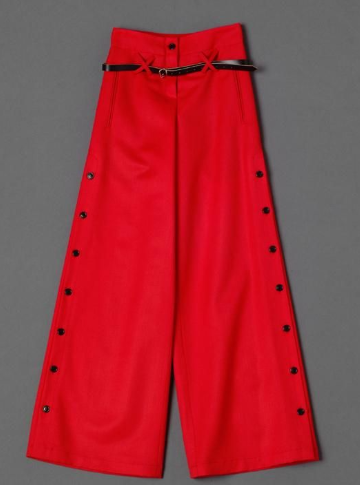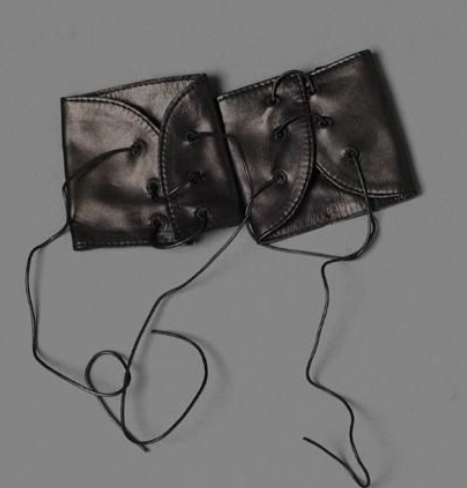Lieve van Gorp Supplemental Article:
- Tyler Thum

- Nov 26, 2023
- 10 min read
Lieve van Gorp supplemental article: Life Before Design, Mariage Exhibit, Life After Design, Interview, and Scans.
Before reading this article, I ask you to please read the prerequisite article, which is also posted on this blog, giving a basis about who Lieve van Gorp is as a designer, and a creative. As well as an introduction to her clothing, and her life. This article will be speaking upon the way that Lieve grew up, as well as her departure from the industry, and what happened afterwards. It will also include a video interview that I found.
Lieve's Family, and Life Before Design.
Starting from the beginning, before Lieve was born. Her father, a man named Raf Van Gorp founded a now multimillion dollar recycling company called, “Revago.” Ravago started with humble beginnings as Raf was a clerk at a gunpowder factory in Poudreries Réunies de Belgique. With little thought at the time, this factory would become his in the near future and be the place where his recycling beast would fruition and become a multi-million-dollar company. To start this tycoon, Raf started selling scrap outside of job hours, slowly accumulating money to start his company. And in due time he did. With at the time 100,000 BEF which now equates to around $2.480 in today's economy. Raf bought a garage with this money. Quickly after the business became too small for the rapid growth that Raf was having. Raf then rented warehouses, and then he was gifted the first piece of machinery to speed up his work. An old Volkswagen, plus a trailer. This to Raf was the signal that he needed to go all out in this industry to prevail. After ten more years, Ravago finally bought their first fork lift machine, which was very expensive at the time, and meant that business was ravaging. Now, with that being said, the Belgian based recycling firm is now worldwide, with factories in America as well as Europe. Raf died in 1993, and a man named Theo Roussis of Greek descent became the head of the company. Theo was also married to another daughter of Raf’s, Gunhilde. Theo then took the business further and made it what it is today.
Now, if you remember, Lieve is a rebellious and a bit of an anarchical being. With designs stemmed in challenging norms, and how fashion is supposed to be perceived. So how would a child, who grew up with a lot of privilege and money, and as well went to catholic schools, would turn to become who she became in the future? Well, I think that I have found an answer to that, with the knowledge of her father being a very wealthy man and the want to escape from what is seen as, “proper.” This now makes sense to me as her father was a very rich man. He put Lieve into catholic school, and he was the one that brought her up to make her become the designer she became. To me, that is fascinating, and it makes sense why Lieve designed the way that she did.
Lieve van Gorp MoMu collection from “Goddess” titled, “Mariage”
From May 8th of 2004 to August 22nd of 2004, an exhibit called “Goddess” was presented by the MoMu in Antwerp, Belgium. This was a take on, “Goddess, the Classical Mode” presented at the Costume Institute of the Metropolitan Museum of Art in New York. This take was chosen by the curator Harold Koda, who is a fashion scholar defined by Google. With garments from a plethora of designers. To name a few, Viktor&Rolf, Azzedine Alaïa, Hussein Chalayan, Thierry Mugler, Patrick van Ommeslaeghe, Gucci, Versace, Maison Margiela, Jean Paul Gaultier, YSL Rive Gauche, Vivienne Westwood, McQueen, Bernard Wilhelm, Romeo Gigli, and the list goes on. Goddess goes into Greek mythology, a realm that some designers poke their nose in, such as the ones listed above.
Now, to get to the point, another person who was asked to curate this space, was Lieve van Gorp. Her space was titled, “Mariage.” Now, this is what I have to think about that. Mariage to Lieve van Gorp is very deep to her. Lieve left her fashion life behind for her partner, A life that was at the time flourishing. Lieve was starting to gain recognition until she closed her brand in 2001 due to her partner Greet contracting a life changing disease, dystonia. Till this day, Lieve is working on finding a cure for this body and mind restricting disease. This to me, is why Mariage is so impactful, and why it was the best to leave like this from the industry, and art as a whole.
Lieve’s exhibit has three parts. The name of the first one, I do not know, the second is called, “Evolution Man,” and the third one is called, “Mooi,” which translates to beautiful in english.
The first exhibit is manned by Lieve van Gorp. Lieve and another man named Peter de Cupure worked on this exhibit together, and this is Lieve’s part of the assignment. This exhibit does not make much sense to me. It feels very unknown to me, nothing like the Lieve I know. I think it represents the hardships of a relationship. As you see in the 5th photo, the windows that eventually lead to the end. This to me, could represent the sludge that happens during a relationship, such as a fight, or a conflict in the relationship, with the video projection at the end, the end goal. The life that you would want with your partner. If you have any other ideas, let me know. Lieve also asked Anne-Mie Van Kerckhoven and the musician Mauro Pawlowski to partake in this exhibit as well.
Images:
The second exhibit titled; “Evolution Man” is curated by Peter de Cupere this time. This time, Peter actually makes clothing. Peter made two identical suits. Possibly representing the unity that comes with a thing such as marriage. In the exhibit there are two suits, one is new, and the other one is old. drab, and faded. The new suit also reeks of perfume to make that feeling of new come straight to your face. Whereas the old suit is dry and is rotten.
Images:
The third exhibit is also manned by Lieve as well. This exhibit is an interior design exhibit that is changed every three months by Lieve herself. With peering windows throughout the exhibit as well. Signifying the space of a married couple.
Images:
Now, my thoughts on this. I think that this is beautiful. With the relations back to Lieve and what she went through with her partner, this exhibit most likely had a big impact on Lieve’s mental health. Thinking about a partner that stays with you your whole life, or is supposed to, while your partner is stuck in a bed all day must have taken a lot of mental fortitude to complete. I personally think that this is very romantic.
Speaking about her home and interior decoration
This is a translated magazine article from Knack.be talking about Lieve van Gorp and the interior of her home. Finding this article was like finding a new piece to a puzzle. I have only seen fashion related content to Lieve, so this to me, is like a breath of fresh air. Also, the interior of someone's house tells a lot more than the clothes they wear to me. A house could be messy and distraught with tangled curtains, cobwebs, and cracking paint on the wall, but the being living inside could wear extravagant clothing with perfect precision and tailoring. Then again, this might also be because they are spending all their money on clothing and not their home. Lieve van Gorp has the privilege to have money to spend on clothing and the interior of her home.
Also, I would love to visit this home. I love Lieve.
THIS ARTICLE NOT MINE THIS IS FOR EDUCATION PURPOSES ONLY. TRANSLATED FROM DUTCH SO SOME WORDING MIGHT BE INCORRECT. THIS WAS WRITTEN ON THE 12TH OF SEPTEMBER 2000.
The interior of fashion designer Lieve Van Gorp is neither fashionable nor trendy. It has something of a literary cabinet with a southern, mysterious atmosphere.
Of all the Antwerp fashion designers, Lieve Van Gorp has perhaps the most authentic interior. It is not voyant or fashionable, but in a subtle way quite artistic in decoration and upholstery. The architecture is quiet and refined, a blessing for the photographer who can capture intimate interior paintings on camera here. It is a home with grateful architecture because the light does not come from everywhere. You have that more with old houses where not every ray of sunlight is taken advantage of and where darkness still has a chance. Moreover, Lieve Van Gorp chose a warm decoration that is rather bohemian in inspiration.
It is a home that could just as easily be situated in an old-fashioned neighborhood of Barcelona or Milan. Or perhaps of Buenos Aires where many lavish mansions from the 19th century have been preserved. The antique mirror ball hanging in the middle of the living room ceiling, by the way, comes from an old dance tent from the land of tango. With a little imagination, you can soak up the atmosphere of a southern metropolis and imagine yourself in the interior of a writer. Although there are perhaps not enough books in the nice library for that. What is certain is that the house exudes something literary and that the interior does not immediately remind you of a fashion designer.
Yet Lieve Van Gorp reveals a piece of her soul here, because she has a thing for old-fashioned interiors and old objects. The building itself is an antiquity. It was probably built just after 1830 in a kind of Biedermeier style. The ceiling betrays that the designer craved more ornamentation after the bloom of the previously prevalent, austere empire style. "It is very beautifully preserved and patinated. But so are the old plank floors and the magnificent windows with old glass," Lieve Van Gorp says enthusiastically. She doesn't understand why such buildings are demolished in Antwerp's inner city. She herself had the building gently refurbished. "Nothing was thoroughly rebuilt. Architect Lou Janssen only drew a metal spiral staircase and a modern kitchen, and provided a beautiful roof terrace. This allows me to enjoy the old winter garden in which the kitchen sits extra."
Such old-fashioned winter gardens of wood and glass are becoming rare. At least with us, because in Paris they are carefully restored. Here, during thorough renovations, they are invariably torn down and replaced by soulless structures made of plastic or aluminum. Lieve Van Gorp's winter garden, however, fits in perfectly with the style of her home. Its interior was also largely preserved, including paneling painted in wood imitation.
Lieve Van Gorp enjoys every detail of her home, from the motifs on the ceilings to the fastenings of doors and windows. After all, she grew up among antiques: "My mother collected them. Even our vacations were dominated by her collecting frenzy." This not only shaped Lieve, but also enriched her in the broadest sense of the word: in her interior we discover some very fine old pieces. The most fascinating is undoubtedly the walnut buffet next to the fireplace. This is a rare Renaissance piece of furniture from Lyon. This city with its many Italian inhabitants was France's gateway to Italy at the time, which explains why furniture was made in the Italian style, of which this cabinet is a prime example. The furniture is much older than all the rest of the interior, but it fits perfectly into the context because it is not on display. The sideboard is simply being used and that is the best way to deal with antiquities.
Above the cabinet hangs a small collection of back-glass paintings, also called églomisés. These beautiful pieces of folk art are deep in color and mysterious in appearance: exactly what Lieve Van Gorp loves.
Not only the antiquities in themselves, but also the various combinations are exciting. Like the pairing of the distinguished, classical furniture with the "tango ball" or with the metal-plate-covered Syrian chairs at the long table. That old tailor's table, by the way, got a nice place in the middle of the living room. "After all, this is primarily a living home, not an exhibition interior," says Lieve Van Gorp. "But I do like to shape my own environment. It's hard for me to imagine creative people having their interior decorated by someone else. To design clothes I proceed a bit like an architect, because then I really construct something, but in the interior I am more of a stylist who decorates."
Original Article Link: Een intiem schilderij (knack.be)
Interview (In Dutch)
This interview, from what I understand with my beginner level Dutch. Lieve is talking about what she primarily wants to focus on as a designer. Lieve says that she mainly wants to make a uniform style with her work, and that she primarily likes using white, black, and gray. Not orange, yellow, and blue as well as other colors of that nature. I do use a little bit of it all though. Finally, that is what I like at the moment for styling and my clothing.
To me, this interview is very special. I think that it is one of the only video interviews that Lieve has ever done. Even though you can't really hear what she is saying you can see her face and put the design work to a face finally. I wonder if she did any other interviews, I just have not seen them yet.
CLICK LINK TO WATCH INTERVIEW
SCANS: (Click Image to see full scans)
Description:
1: Lieve Van Gorp, AW2000-2001 page 68 from Het Modemuseum
2: Jonathan Davis wearing a Lieve Van Gorp long sleeve for “Interview with a Vampire” - Jonathan Davis interview for Revolver Magazine, March 2002.
3: Lieve van Gorp AW99
4: Someone from Detour Magazine wearing a Lieve van Gorp vest
5: Lieve van Gorp AW99
6: Lieve van Gorp AW99
7: Lieve van Gorp AW98
8: A photo from the AW01 of Lieve van Gorp titled, "Forever Yours."
9: A collage of men and women wearing Lieve van Gorp AW98
More photos of her work. (Click Image to make bigger)
Descriptions:
1: Red pants from Lieve van Gorp. There is also a red top with this as well, with the Margiela Cigarette shoulder. Beautiful wide leg and studded sides. (She did it before Rick) and as well as an extravagant slim leather belt to tie it all together.
2: Black leather gown
3: A long black leather gown. Most likely from SS/00. Very high quality and of course, very Lieve.
4: Lieve van Gorp leather wrist cuffs. GekkaSantuary actually had these, and I wanted to buy them off of him but sadly he sold them before I got the chance. T_T
5: Modular Gray wool trousers. Literally quite literally one of my favorite pieces from her. I would never wear it, but I appreciate it indefinitely.
6: This is a black leather chamois dress with pink paint splattered over top. The closures consist of leather straps and metal buckles. Beautiful dress.
7: Long gray wool dress. Simple, but effective
8: One of Lieve’s first accessories. To me it looks like a wallet, although it could be something else.
9: Black hip belt made from leather. I love the cut of this skirt. It gives me doll vibes, possibly ballerina.
10: Gray twill apron, with an added chest piece with a black leather collar and straps.
11: "In my dreams I am a rockstar!" part of this quote was in the title of my last article on Lieve. This collection is my favorite from her by far.
12: Victim or Hero Joan of Arc shirt. Very provoking, and rebellious at the time.

















































Comments